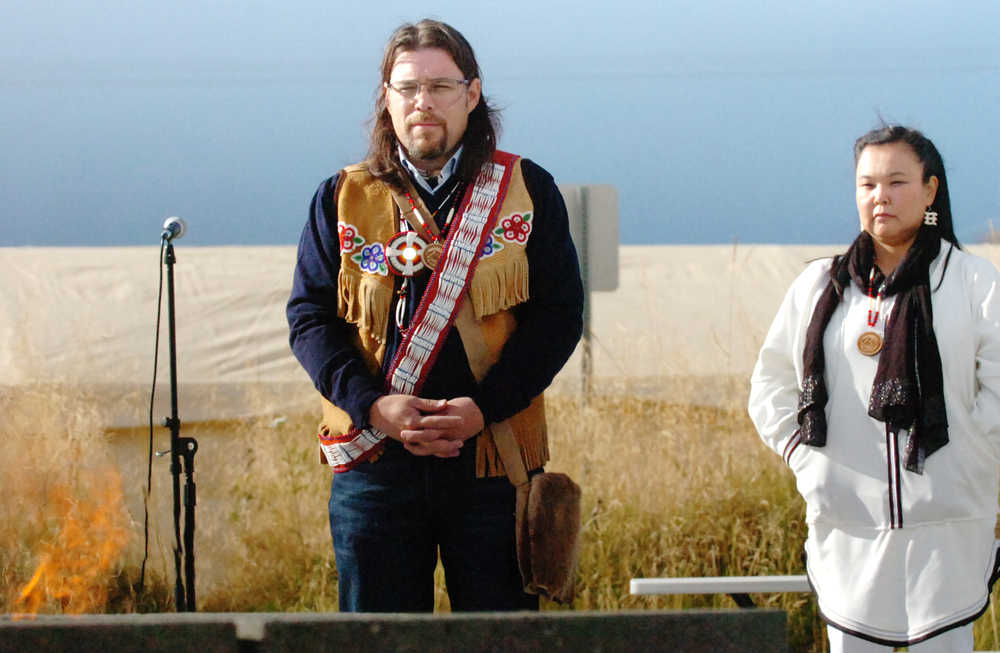Ggugguyni T’uh is the name of the new outdoor ceremonial space dedicated on Saturday by the Kenaitze Indian Tribe at their Dena’ina Wellness Center in old town Kenai. The space’s designer Jon Ross said the name translates literally as “Raven Place,” although it will be more formally called Raven Plaza. The plaza is centered on a fire pit ringed by a stone design created by Ross, and further out by a low wall for ceremonial spectators to sit on.
Ross said the raven of the plaza’s name brought light to the world in a traditional Native story, reflecting the name of his design: Nak’eljay — “We have the light.” Nak’eljay consists of concentric rings that represent ways Native cultures measured time. The innermost ring represents a day. Outside it are the phases of the moon, the tide, the months, and a timeline representing 400 years of history. Although the timeline is unmarked, Ross said he designed it with specific years in mind. The point where the tidal ring shows the tide going out, Ross said, corresponds to the year 1838, when hundreds of Dena’ina were killed by an influenza epidemic. From this starting point, Ross said that the lowest time in Dena’ina history — 1959, the year of Alaskan statehood — occurs in the dark of the new moon. Ross ended his explanation at the year 2025, in which his design shows the tide returning.
For the Dena’ina Wellness Center, the cultural revival symbolized by the returning tide includes its new Traditional Healing Program, which opened in August. Kenaitze Indian Tribe Health Systems Director Dr. John Molina said that the Traditional Healing Program has already begun serving patients, beginning with elders. Dr. Molina, trained as a physician, said that traditional healing is very different from the conventional medicine that he and other providers at the Wellness Center practice.
“Our providers here will treat you with antibiotics, stitch you up, give you something you need for your cough,” Molina said. “It’s all medicine, and it’s all good. … We focus on just the body. We don’t worry about the social, mental, emotional, spiritual. It’s all physical. If you have a heart attack, we give you drugs and give you surgery. That’s the way the medical model works. Traditional healing understands that healing is all about mind, body, spirit, and family.”
Molina said that both types of treatment can work for specific individuals.
“What we want to offer to our patients is a choice,” Molina said. “The opportunity to be healed by Western-trained medicine. The opportunity to be healed by a traditional healer, to have ceremony and prayer, all those things that affect the individual and their health and illness. Because everybody has a different belief about health and illness.”
In addition to the ceremonial plaza, Saturday’s dedication also blessed the Traditional Healing Program’s first Tribal Doctor, Estelle Thomson. In April Thomson moved to Kenai from Anchorage, where she has a massage therapy practice, Northern Bodyworks. As a Tribal Doctor, Thomson will continue doing massage and visceral manipulation, adding to them cultural elements, such as prayers and rituals, from Native tradition.
“Dysfunction in the body can be something that’s environmental,” Thomson said. “We look at possible emotional and spiritual connections.”
Along with the Nak’eljay design, a second piece of art was featured at the ceremony. Sculptor Joel Isaak, who also created the Wellness Center’s bronze sculptures of a Native fisherman and family drying salmon, erected his piece “Lay Your Burdens Down” — a circular enclosure of tanned moose hides — in the lobby of the Wellness Center. Originally created in 2012 as Isaak’s thesis project in the art program at University of Alaska Fairbanks, the sculpture now belongs to the Kenaitze Tribe and will be used in ceremonies and events at the Wellness Center, Isaak said. Viewers of the sculpture are meant to use it in a ceremonial way. The moose-hide circle forms a path that viewers can travel, carrying a stone symbolizing psychological burdens, which can be deposited in the center of the piece, symbolizing release. Isaak, spoke of how creating the sculpture was a kind of healing for him.
In an artist’s statement distributed at the dedication, Isaak wrote that the work was inspired by the shock he said he experienced as a freshman at UAF on learning a statistic: one in four women will be sexually assaulted before the age of 25. Isaak said the work was a response to domestic and sexual violence, which he said were related to the violence of history.
“There are things within the Native community that affect men,” Isaak said. “Some of those are hunting and fishing and training with uncles. That is what keeps young men well, in a very general statement. Those things were challenged, and still are challenged today. As far as wellness, when you take away those things from a human being, they feel powerless. And when people feel powerless, they act out with fear and anger, and on people who are physically weaker. In general that tends to be women and children.”
Thomson also alluded to hunting and harvesting when she said that one activity of the Wellness Center’s Traditional Healing Program is food gathering. She helps patients help themselves by teaching how to find, gather, and use medicinal plants. In addition to the medicine itself, she said that the process of gathering can also be a treatment.
“There’s research that’s proved that going out into the woods and having a connection to the earth does all sorts of things to the body,” Thomson said. “For us that can be part of a spiritual practice. Being able to utilize those resources and have that relationship with nature is very important. So some of what we do is geared toward spiritual wellness.”
Reach Ben Boettger at ben.boettger@peninsulaclarion.com.

